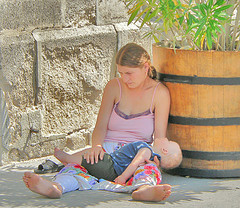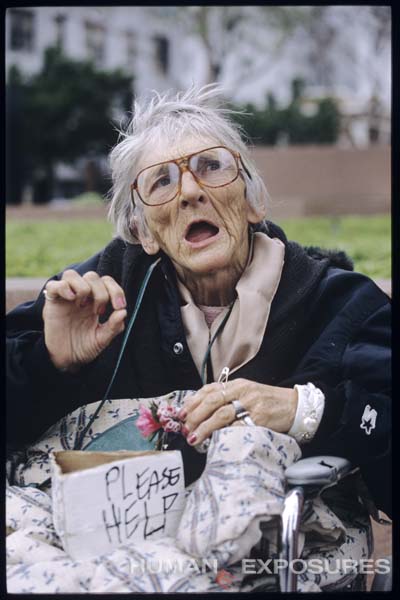Put on by the Greater Minnesota Housing Fund (GMHF), a photography show called “Portraits of Home II: Veterans in Search of Shelter in Greater Minnesota” uses art and documentation to put human faces to the tragedy of our street population. The attitude and the ethical concepts behind the exhibit are stated on the GMHF website:
Art, especially photography, can be a powerful tool for increasing public awareness of the affordable housing crisis facing people in Greater Minnesota. Photographs personalize the human impacts of poor housing conditions and homelessness. They capture the dignity and resiliency of people managing everyday life with few resources and the positive changes that can occur with stable housing. Greater Minnesota Housing Fund is making this compelling exhibit available to local communities throughout 2009 and 2010 in order to touch the hearts and minds of policymakers, local leaders and residents, and to inform these stakeholders of the specific actions they can take to address the housing challenges faced by a growing number of Minnesota families.
The show seems to be doing a good job of generating discussion of the issue. Currently at Winona State University, it was written up in the Winona Daily News:
Ruth Charles, a WSU professor, helped coordinate the event. She hopes the exhibit serves as ‘a piece of education’ and ‘makes the connection’ to viewers that all too often troops are not supported when they return home.
The photos capture an ‘incredibly important piece of history,’ especially right now, as ‘we’ll have a tsunami of veterans coming back to the states’ from Iraq and Afghanistan, said Stormi Greener, a freelance photographer whose work is on display in the exhibit.
One veteran whose photo appears in Minne Hall was deployed to Iraq for 22 months, during which time the house he had been living in was sold. Photographer Brian Lesteberg captures the veteran sitting in the open trunk of his car, where he has been living for more than three months.
We obviously believe in the power of art, image and narrative as catalysts for change. Just take a look at our published offerings. It is said that “a picture is worth a thousand words,” and, in cases like these, we’d say that it’s certainly true. You can quote the dismal statistics of the situation, or you can show someone a picture of a child living on the streets. All too often, it’s the image that catches people’s attention first, and that’s why shows like this one are vitally important.
Take a look at Susan Madden Lankford’s downTown USA: A Personal Journey with The Homeless, or Deborah Luster‘s “One Big Self” to see how much humanity can be communicated by a simple photograph. And, really, that is what is so often absent — simple humanity. While walking past a homeless person in the street, most people have trained themselves to look away, but that same reflex does not occur when they’re looking at photos. We would wager that viewing photos like this provides the first in-depth perception of homelessness for more than a few people.
Source: “Portraits of Home II,” Greater Minnesota Housing Fund, undated
Source: “WSU photo exhibit shines a light on homeless veterans,” Winona Daily News, 09/17/10
Image by NAME, used under its Creative Commons license
Visit Us on Facebook: Humane Exposures Publishing , downTownUSA, Maggots in My Sweet Potatoes, It’s More Expensive To Do Nothing

 Oprah Winfrey has become a household name, there is no mistake about that. Over the course of her career, she had experienced success in a wide variety of arenas ranging from the big-screen movies to her rightfully famed talk show. This is exactly why we feel that she should revisit the topic of homelessness in the U.S.
Oprah Winfrey has become a household name, there is no mistake about that. Over the course of her career, she had experienced success in a wide variety of arenas ranging from the big-screen movies to her rightfully famed talk show. This is exactly why we feel that she should revisit the topic of homelessness in the U.S. The Seattle Times recently did a
The Seattle Times recently did a  As part of its Third Wednesday Series, the
As part of its Third Wednesday Series, the 
 As we watch the economy spiral seemingly out of control, the specter of homelessness looms disturbingly close for people of all socioeconomic strata. Add in the chaos in the American housing market, and the picture becomes starkly unpleasant.
As we watch the economy spiral seemingly out of control, the specter of homelessness looms disturbingly close for people of all socioeconomic strata. Add in the chaos in the American housing market, and the picture becomes starkly unpleasant. When you hear about the homeless issues in the media, it often seems that the solutions being attempted are usually centered on housing. While, at first glance, this seems the most efficient approach, it is hardly a panacea. In order to maintain a roof over their heads, the homeless need other things. Sometimes it is discipline, sometimes it is substance-abuse treatment, sometimes it is a matter of helping them become employable.
When you hear about the homeless issues in the media, it often seems that the solutions being attempted are usually centered on housing. While, at first glance, this seems the most efficient approach, it is hardly a panacea. In order to maintain a roof over their heads, the homeless need other things. Sometimes it is discipline, sometimes it is substance-abuse treatment, sometimes it is a matter of helping them become employable. As you walk through the streets of San Diego, or any other American city, you will see the homeless. People living rough in the urban landscape. Each one is somebody’s brother, mother, son, cousin, or spouse. In addition, many of them had fought for our country.
As you walk through the streets of San Diego, or any other American city, you will see the homeless. People living rough in the urban landscape. Each one is somebody’s brother, mother, son, cousin, or spouse. In addition, many of them had fought for our country. HUMAN
HUMAN








